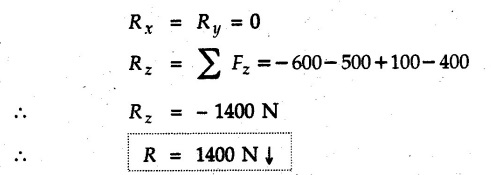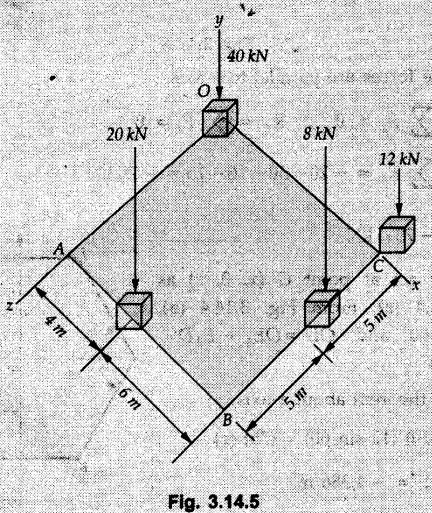Engineering Mechanics: Unit II: Equilibrium of Rigid Bodies
Resultant of Parallel Space Force System
with Solved Example Problems
The resultant of a parallel force system in space is a force parallel to the given force system.
Resultant of Parallel Space Force System The resultant of a parallel force system in space is a force parallel to the given force system. The position of the resultant force can be obtained using Vanon's theorem about two different axes perpendicular to the plane of the forces. Example 3.14.1 The slab in Fig. 3.14.1 is subjected to parallel forces. Determine the magnitude and direction of resultant force equivalent to the given force system and locate its point of application on the slab. Solution: Let the resultant act at point(x,y,0) on the slab. Using Varignon's theorem about Y-axis, (600) (8) - (100)(6) = (1400)(x) Using Varignon's theorem about X-axis, (100)(5) - (400)(10) = −(1400)(y) The resultant acts at point (3, 2.5, 0) on the slab. Example 3.14.2 Find resultant of the four parallel forces shown in Fig. 3.14.2. Where will it act ? Solution: Rx = Ry = 0 as all given forces are in Z-direction. Rz = -4 – 3 + 5 – 6 = - 8 ⸫ R = 8 kN↓ Let this resultant act at point (X, Y, 0). Taking moment about Y-axis, using Varignon's theorem, 4 × 4 + 3 × 1 – 5 × 2 + 6 × 1 = 8 × X ⸫ X = 1.875 Using Varignon's theorem about X-axis. - 3 × 1 + 5 × 3 – 6 × 4 = -8 × Y ⸫ Y = 1.5 ⸫ The resultant acts at (1.875, 1.5, 0) m Example 3.14.3 ABCDEFGH is a regular octagon of side 4 m. Fig. 3.14.3 shows positions of six columns which carry vertical forces normal to plane of octagon and acting at its six corner points. Locate the resultant of these forces w.r.t. centroid of octagon 'O'. Solution: Consider the top view as shown in Fig. 3.14.3 (a). As all forces are in z-direction, Example 3 14 4 A concrete mat in the shape of a regular hexagon of 12 m sides (ABCDEF) supports four column loads as shown. Determine resultant and co-ordinates of point where it acts on the mat. Also find additional loads which must be applied at B and F so that resultant of six parallel forces will pass through center of mat. Solution: As all the forces are parallel to y-axis, ⸫ Resultant acts at point G (4.8, 0, 1.386). Let W1 and W2 act downwards at B and F respectively. Then using Varignon's theorem about x-axis. (W1) (12 sin 60)- (W2) (12 sin 60) + (10) (12 sin 60) (20) (12 sin 60) = 0 ⸫ W1 - W2 = 10 ... (1) Using Varignon's theorem about z-axis, (W 1) (6) + (W 2) (6) + (15) (12) - (20) (6) − (10) (6) — (30) (12) = 0 ⸫ W1 + W2 = 60 ... (2) From equation (1) and (2), Example 3.14.5 A square foundation mat supports the four columns as shown in Fig. 3.14.5. Find the magnitude and point of application of the resultant of the four loads. Solution : Let the resultant act at point (x, 0, z). Using Varignon's theorem about z-axis, −(20)(4) - (12)(10) – (8)(10) = (80) (x) ⸫ x = 3.5 m Using Varignon's theorem about x-axis, (8)(5) + (20)(10) = (80)(z) ⸫ Z = 3 m ⸫ Point of application of the resultant is (3.5, 0, 3) m. Example 3.14.6 Find the resultant force and its location of the force system`shown in Fig. 3.14.6. The (x, z) coordinates of the points of application of the forces are given in metres. Solution :Solved Examples for Understanding














Engineering Mechanics: Unit II: Equilibrium of Rigid Bodies : Tag: : with Solved Example Problems - Resultant of Parallel Space Force System
Related Topics
Related Subjects
Engineering Mechanics
ME3351 3rd semester civil, Mechanical Dept | 2021 Regulation | 3rd Semester Mechanical Dept 2021 Regulation
